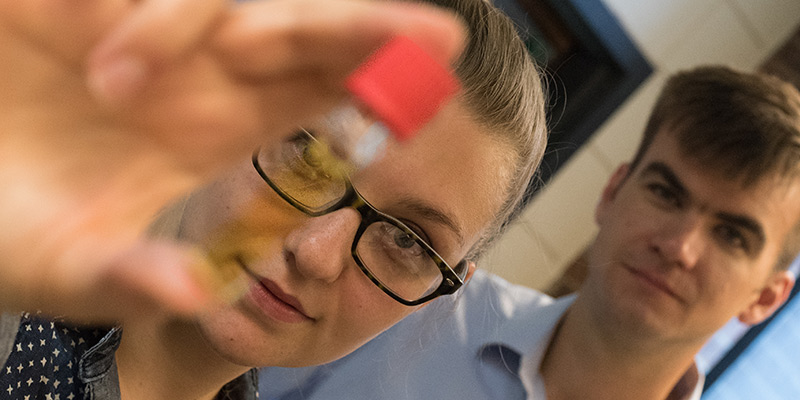Researchers at Vermont University and Dartmouth College have found a luminescent liquid that does not seem to obey a long standing law of chemistry called Kasha’s Rule.

UVM doctoral student Morgan Cousins holds up unusual dye containing Boron. -Photo curtesy of Joshua Brown
Light Emission Didn’t Behave as Expected
The researchers were examining the properties of molecular rotors suspended in a liquid. The molecules they were testing contain boron and give off a weak reddish glow when in water. However, when they placed the molecules into thicker and thicker (maple syrup-like) solvents such as mixtures of glycerol and ethylene glycol, the fluorescent light from the molecular rotors didn’t weaken as expected according to Kasha’s Rule. Instead, the molecules glowed a bright and vivid green color nearer the blue end of the spectrum.
“It’s a new method to create light,” according to Matthew Liptak, a chemist at the University of Vermont who co-led the new research.
The world has color largely because molecules absorb and give off light following the “spooky” rules of quantum mechanics. In most cases, a molecule will absorb a particular light wavelength, and we will see its complement on the color wheel. However, certain molecules “glow in the dark” (luminesce) by emitting a specific color of light a short time after absorbing light.
Kasha’s Rule
In 1951, Michael Kasha discovered that a luminescent molecule generally emits the same color light regardless of the color of light that it initially absorbed. After light is absorbed, the molecule “relaxes” through a rapid vibration, stretching and release of heat to bring the molecule to its “lowest energy excited state,” Liptak explained. So when a typical luminescent molecule absorbs light towards the blue end of the spectrum, which has higher energy, it produces more heat, not brighter or different-colored luminescence because of Kasha’s rule, Liptak notes.
How They Concluded that The Kasha’s Rule was Broken
The UVM team investigated the unexpected behavior with simulations on the Vermont Advanced Computing Core and both teams further investigated the molecules with spectroscopy and other lab techniques. They arrived at a surprising conclusion. The way the light was being emitted required breaking the law of chemistry called Kasha’s Rule.
Through the simulations, they found that unlike conventional luminescence, the rotor molecules emit light instead of heat when suspended in a thick solution because their capacity to vibrate is limited.
For this reason, promising applications for the new material include novel kinds of LED bulbs and medical dyes “that can sense viscosity within a cell,” Liptak says.
The researchers detailed the discovery in Sept. 26 issue of the journal Nature Chemistry.





